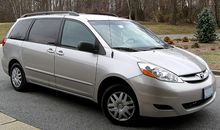Toyota Sienna
| Toyota Sienna | |
|---|---|
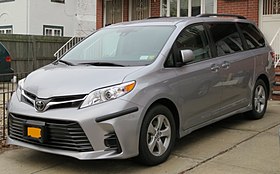 | |
| Overview | |
| Manufacturer | Toyota |
| Production | 1997–present |
| Model years | 1998–present |
| Body and chassis | |
| Class | Minivan |
| Chronology | |
| Predecessor | Toyota Previa (North America) |
The Toyota Sienna (Japanese: トヨタ・シエナ Toyota Shiena) is a minivan manufactured by Toyota at the Toyota Motor Manufacturing Indiana facility, in Princeton, Indiana, United States, for the North American market. It replaced the first generation Previa van in 1997 with a more conventional front-wheel drive layout and shares a heavily revised platform with the Camry.[1] Both the Previa and original Sienna were smaller than the other minivans they competed against, but a redesign in 2003 (for the 2004 model year) increased the dimensions to match those of its competitors.[2] The Sienna is currently the only minivan in its class to offer all-wheel-drive.[3] It was redesigned a second time in 2010 (for the 2011 model year). The third generation Sienna went on sale in the United States in February 2010 and is the first Sienna to ever receive a "Top Safety Pick" award from the Insurance Institute for Highway Safety. Exports from the United States to South Korea began in November 2011.[4][5]
Contents
First generation (XL10; 1997–2002)[edit]
| First generation (XL10) | |
|---|---|
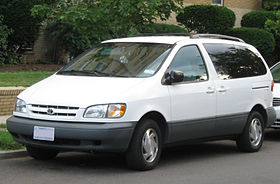 | |
| Overview | |
| Production | August 1997 – December 2002[6][7] |
| Model years | 1998–2003 |
| Assembly | United States: Georgetown, Kentucky (TMMK) |
| Designer | Hosoda Ikuei, Yamaji Shinichi, Mitsunori Miyazaki, Hiroaki Shibata, Hiroaki Suzuki (1994)[8] |
| Body and chassis | |
| Body style |
|
| Layout | Front-engine, front-wheel-drive |
| Powertrain | |
| Engine | 3.0 L 1MZ-FE V6 |
| Transmission | |
| Dimensions | |
| Wheelbase | 114.2 in (2,901 mm) |
| Length |
|
| Width | 73.4 in (1,864 mm) |
| Height | 67.3 in (1,709 mm) |
| Curb weight | 3,973 lb (1,802 kg) |

In late 1997, Toyota launched the front wheel drive MY 1998 Sienna in the North American market as a replacement for the mid-engined Previa. The Sienna debuted with a 3.0-liter 1MZ-FE V6 engine rated at 194 hp (145 kW) and 209 lb⋅ft (284 N⋅m) of torque. Built on an extended platform of the Toyota Camry, the Sienna was appropriately marketed as the "Camry of minivans," capitalizing on the Camry's popularity and reputation. It is named for the Italian city of Siena, in the region of Tuscany.
It came in three trim levels, CE, LE, and XLE. The LE and XLE models were equipped with 2nd row captain's chairs while the CE models came equipped with a 2nd row 2-passenger bench seat. The seats can be easily folded and individually removed as needed. The driver side sliding door and roof rack were standard on the LE and XLE models, but were optional on the CE models. The XLE models offered leather seats and a wood trim package. The Sienna also touted best-in-class fuel economy of 16 mpg city driving and 22 mpg highway driving. It was built in Georgetown, Kentucky. A year after its release, the Sienna faced new competition from the redesigned Honda Odyssey minivan, which was larger and offered a V6 like the Sienna.
For the 2001 model year, the Sienna underwent a
mid-cycle refresh. This update included a facelift to both front and rear fascias which added a redesigned front grille and bumper along with revised rear taillights sporting a more modern appearance (clear-lens turn-signals as opposed to amber-coloured). Toyota also revamped the center console area to add more usability to the HVAC controls along with new locations for the accessory switches (rear vent, power sliding doors, heated seats). The engine also came equipped with a variable valve timing feature VVT-i boosting output to 210 hp (157 kW) and 220 lb⋅ft (298 N⋅m) torque. The driver side sliding door became standard on all models, although the roof rack remained optional on the CE models.
This generation was noteworthy for its impressive safety content as one of the few minivans to offer options including front seat-mounted side torso airbags and Vehicle Stability Control. Anti-lock braking was standard. The Insurance Institute for Highway Safety rated the Sienna "Good" in all six frontal crash test measures, which was far better than the Previa.[9]
The reputation of this generation was marred by a class-action settlement for an engine oil sludge problem which affected the V6 engines in many Toyota models. Symptoms of the problem include oil smoke in the exhaust, oil quickly becoming dark or black after an oil change, gasoline odor in the oil, high oil consumption, and eventually engine failure.
| Frontal Driver: | |
| Frontal Passenger: | |
| Side Driver: | |
| Side Rear Passenger: |
Second generation (XL20; 2003–2009)[edit]
| Second generation (XL20) | |
|---|---|
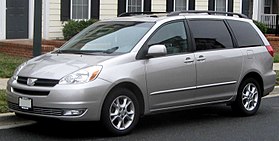 | |
| Overview | |
| Production | January 2003 – December 2009[11] |
| Model years | 2004–2010 |
| Assembly | United States: Princeton, Indiana (TMMI) |
| Designer | Kevin Hunter (2000) |
| Body and chassis | |
| Body style | 5-door minivan |
| Layout | |
| Platform | Toyota K platform |
| Powertrain | |
| Engine | |
| Transmission |
|
| Dimensions | |
| Wheelbase | 119.3 in (3,030 mm) |
| Length |
|
| Width | 77.4 in (1,966 mm) |
| Height | 68.9 in (1,750 mm) |
| Curb weight |
|
Toyota assigned Yuji Yokoya as chief engineer on the new Sienna project. Yokoya and his family drove the previous model over 53,000 miles (85,000 km) throughout North America to find weaknesses from the design.[12][13] The engine was an updated ULEV certified 3.3-liter 3MZ-FE V6 paired with a new five-speed automatic transmission. The gear stick was moved from the steering column to the center console and had a gated shift pattern. Seating for eight was optional on lower-level trims, and the third row seating was fold-flat,[14] allowing the van to transport 4 by 8 feet (1.2 by 2.4 m) building materials like plywood and drywall sheets.
On January 6, 2003, the second-generation Sienna was unveiled at the Detroit Auto Show.[13] Production was moved from the Georgetown plant to Toyota Motor Manufacturing Indiana.[13] Changes from the first generation included 45% more volume overall and 39% more cargo space. The seats were in the 60/40 split configuration, and the flat-folding third row seat was offered even with all-wheel-drive.[1]
Trim levels, in order of increasing standard and available features were: CE, LE, and XLE, and XLE Limited (renamed Limited in later years). The most distinguishable difference on the XLE Limited model was the horizontal chrome bar placed above the rear license plate. The CE had a black trim there, while middling models had a body-colored trim.
Standard features included remote keyless entry, tilt-and-telescopic steering wheel, and high solar energy-absorbing glass (HSEA) on the windshield and front windows. All 2004–2007 Siennas had a factory tow package (hitch kit and trailer lighting connections not included[clarification needed]) and a 3,500 pounds (1,600 kg) towing capacity.
All wheel drive, optional on the more expensive trims included run-flat tires. The all wheel drive system continuously divided engine power 50:50 front and rear.[15]
Options, depending on the trim level, included HID Xenon headlamps, Dynamic Laser Cruise Control, parking sensors, a convex rear view mirror to enable the driver to see the passengers, a voice-activated navigation system (not voice activated for the 2004/2005 model year) which included a backup camera, 10-speaker JBL audio and rear-seat DVD entertainment system with two 110 V outlets.
New styling allowed for a drag coefficient of Cd=0.30. EPA Fuel economy was 17 mpg city driving and 23 mpg highway for the FWD version. The AWD version got 16 mpg city driving and 22 mpg highway driving. The turning radius was 11.2 metres (37 ft).
Safety[edit]
The Sienna came standard with anti-lock braking, brake assist, electronic brakeforce distribution, traction control and a tire-pressure monitoring system. Side torso airbags, and side curtain airbags were standard on certain 2004 and 2005 LE and XLE model trims while optional on others, but became standard on all 2006 trims. Vehicle Stability Control initially optional on lower trims became standard for 2008 models.
The IIHS gives the Sienna an overall "Good" score in their frontal offset crash test with "Good" marks in all six measured categories. All 2006 models and later receive a "Good" overall score, while pre-2006 models without side airbags receive an "Acceptable" score for side impacts.[16]
| Frontal Driver: | |
| Frontal Passenger: | |
| Side Driver: | |
| Side Rear Passenger: | |
| 2WD Rollover: |
| Frontal Driver: | |
| Frontal Passenger: | |
| Side Driver: | |
| Side Rear Passenger: | |
| 2wd Rollover: |
Model year changes[edit]
- 2006: the front fascia, side molding, and headlamps were restyled. Blue-backlit electroluminescent Optitron gauges were added to LE, XLE, and Limited trims. The "XLE" prefix in "XLE Limited" was removed, and new exclusive equipment for this trim included an optional memory function for the driver's power seat and side-view mirrors (also available on XLE as an option) and power-folding exterior side-view mirrors with integrated in-glass LED turn-signal repeaters. Other options included Bluetooth and a power-folding third-row seat. Front row side torso airbags and side curtain airbags for all three rows became standard equipment on all models. The optional rear seat audio system was discontinued. Horsepower and torque ratings were changed to meet SAE's new standard to 215 hp (160 kW) and 222 lb·ft (from 230 hp (172 kW) and 242 lb⋅ft (328 N⋅m), Toyota also now rates engines on 87 octane).
- 2007: a new ULEV-II certified 3.5-liter 2GR-FE V6 engine rated at 266 hp (198 kW) with a rated fuel economy of 17/23 MPG for front-wheel-drive models and 16/21 MPG for AWD models replaced the 3.3-liter V6. The tire pressure monitor was upgraded, and a new seven-spoke alloy wheel design was made exclusive to the Limited and AWD models.[19]
- 2008: Vehicle Stability Control became standard in all trims.
- 2009: the Sienna remained largely unchanged, except for a revision in pricing to become more competitive through several available comprehensively equipped "extra-value package" offerings. In Canada, base prices were lowered by up to $1,500.[20]
- 2010: the second generation Sienna was unchanged in its final model year.[21]
Third generation (XL30; 2010–present)[edit]
| Third generation (XL30) | |
|---|---|
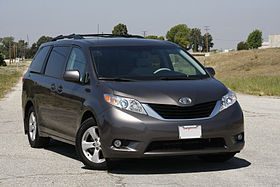 | |
| Overview | |
| Production | January 2010 – present[22] |
| Model years | 2011–present |
| Assembly | United States: Princeton, Indiana (TMMI) |
| Designer | Ian Cartabiano and Kazuo Mori (2007) |
| Body and chassis | |
| Body style | 5-door minivan |
| Layout | |
| Platform | Toyota K platform |
| Powertrain | |
| Engine | |
| Transmission |
|
| Dimensions | |
| Wheelbase | 119.3 in (3,030 mm) |
| Length | 200.2 in (5,085 mm) |
| Width | 78.2 in (1,986 mm) |
| Height |
|
| Curb weight | 4,310 lb (1,950 kg) |
The redesigned 2011 Sienna premiered at the Los Angeles Auto Show in early December 2009. It was designed at Calty studios and engineered at Toyota Technical Center in Ann Arbor, Michigan and Toyota Motor Corporation in Japan.[23] The new Sienna arrived at dealers in February 2010.[24]
The Sienna is offered in five trim levels, the Sienna base grade, LE, XLE, Limited and for the first time the SE trim. The new SE offers revised bodywork, clear tail lamps, 19-inch (480 mm) wheels, firmer suspension and revised steering tuning for a sportier ride. All-wheel-drive is only available with the V6 engine on the LE, XLE and Limited model trims. Described by AOL Autos as slipping a sports car in a minivan, Chief Engineer Kazuo Mori (an avid autocrosser) reportedly had to overcome opposition to get the SE equipment package included in the line-up.[25]
The previous 3.5-liter 2GR-FE continues, but for the first time the Sienna offers a four cylinder engine, the 1AR-FE; and is the first time Toyota has offered a four-cylinder engine in a North American minivan since discontinuation of the Estima/Previa in late 1997. An Electric Power Steering (EPS) system replaces the previous hydraulic power steering system. Toyota continues to offer all wheel drive in the Sienna. It is the only North American minivan with an available AWD drivetrain.[26] Toyota expects EPA-estimated mileage figures of 19 mpg‑US (12.4 L/100 km) city / 24 mpg‑US (9.8 L/100 km) highway for models powered by the 4-cylinder engine, 18 mpg‑US (13.1 L/100 km) city / 24 mpg‑US (9.8 L/100 km) highway for 2WD V6 models, and 16 mpg‑US (14.7 L/100 km) city / 22 mpg‑US (10.7 L/100 km) highway for AWD models. An optional tow package for V6 models is rated to tow 3,500 pounds (1,600 kg).
The front dashboard features a "swoop" wood trim, inspired by the Toyota Venza and Lexus RX, that gives front seat occupants a "60/60" split whether in the driver or passenger seat.[25]
New features include an optional sliding second row with "Lounge Seating" recliner style chairs, a feature previously seen on the Lexus LS,[27] and Toyota's keyless Smart Key System with push-button start. The rear seat entertainment option now uses a 16.4-inch (41.7 cm) LCD screen which operates in two view modes, a single 16:9-ratio widescreen or two separate 4:3-ratio split screens with separate wireless headphones.
For safety the back-up camera comes with a new 180° panoramic view. Other new options include a Pre-Collision System (PCS) as well as an automatic highbeam dimmer, Safety Connect and a more advanced stability control system known as Vehicle Integrated Dynamics Management. A driver's knee airbag is now standard as well.
When the second row seats are removed, the bottom of the second row seats, which is similar to a rack, remains attached to the van floor. This means that with second row seats removed, the floor is not flat.[28]
Toyota is the first automaker to offer a factory installed auto-access seat for disabled people. The one-touch rotating, power ascending/descending lift-up seat can lower to within 19 inches (48 cm) of the ground.[29]
Model year changes[edit]
- 2012: Toyota's new navigation system with Entune connected navigation system became available.
- 2013: The four-cylinder engine was dropped and replaced with the 2GR-FE V6.
- 2015: Minor refresh with new tail light and interior design was featured, although the Sienna SE retained the original "sport" tail lights while the rest of the trims received new tail lights (L, LE, XLE, and Limited). Toyota added three new colors (Sky Blue Pearl, Creme Brulee Metallic, and Attitude Black Metallic). For the Limited and SE models, the Sienna features refreshed headlights with LED daytime running lights.
- 2017: The six-speed automatic transmission was replaced with an eight-speed and a revised 2GR-FKS engine adding Toyota's D4-S direct injection fuel system.[30] The new engine increased power to 296 hp (221 kW), with torque increased to 263 lb⋅ft (357 N⋅m).[31]
- 2018: a mild facelift with a new front grille, new headlights, new side skirts, standard Safety Sense, minor noise and vibration enhancements, and additional technology like extra USB ports, an updated rear entertainment system (for models equipped with this option), and a semi-digital instrument cluster.[32] The new grille is available in 3 styles: On the XLE and Limited, a chrome pair of wings bisects the grille. On the LE, the wing is black. The SE grille has no wing. The 2018 model year has standard automatic emergency braking, adaptive cruise control, lane-departure warning with lane-keeping assist, and automated high-beams.[33]
- 2019: All wheel drive became available on the SE trim and the Limited trim with FWD is no longer offered. CarPlay support is introduced alongside the Entune 3.0 media system.
Sales[edit]
| Calendar year | US |
|---|---|
| 2000 | 103,137[34] |
| 2001 | 88,469[citation needed] |
| 2002 | 80,915[35] |
| 2003 | 105,499[citation needed] |
| 2004 | 159,119[36] |
| 2005 | 161,380[citation needed] |
| 2006 | 163,269[37] |
| 2007 | 138,162[citation needed] |
| 2008 | 115,944[citation needed] |
| 2009 | 84,064[citation needed] |
| 2010 | 98,337[38] |
| 2011 | 111,429[38] |
| 2012 | 114,725[39] |
| 2013 | 121,117[40] |
| 2014 | 124,502[41] |
| 2015 | 137,497[42] |
| 2016 | 127,791[43] |
| 2017 | 111,489[44] |
| 2018 | 87,672[45] |
Awards[edit]
2004:
- Car and Driver's Five Best Trucks Van Award
- Edmunds Editor's Most Wanted Van[46]
- Edmunds Consumers' Most Wanted[47]
2010:
- Best Resale Value Award[48]
- Insurance Institute for Highway Safety's "Top Safety Pick" Award (2011 model year only)
2019:
- Longest-Kept Minivan[49]
References[edit]
- ^ Jump up to: a b Williams, Mark (4 June 2003). "First Drive: 2004 Toyota Sienna". Motor Trend. Retrieved 12 November 2009.
- ^ Bartlett, Jeff (30 May 2003). "First Drive: 2004 Toyota Sienna XLE Limited". Motor Trend. Retrieved 12 November 2009.
- ^ "First Look: 2009 Toyota Sienna". Motor Trend. 8 October 2008. Retrieved 12 November 2009.
- ^ Emerson, Danielle (1 November 2011). "Toyota to export U.S.-built Sienna to South Korea". Automotive News. Retrieved 7 January 2016.
- ^ "Toyota Announces Plans to Export U.S.-Assembled Sienna to South Korea" (Press release). US: Toyota. 1 November 2011. Retrieved 7 January 2016.
- ^ "A look at Toyota's 25 years in Kentucky". KyForward. Lexington, Kentucky. Archived from the original on 12 November 2014.
- ^ "Toyota's Sienna Minivan Leaving Georgetown Plant". Kentucky: Toyota. 19 December 2012. Retrieved 29 June 2014.
- ^ https://www.j-platpat.inpit.go.jp/c1800/DE/JP-1011668/A27F53081C253D5B518C12DAD8881D8E9B3545D2E87EA8B7DD203755029C4273/35/en
- ^ "IIHS-HLDI: Toyota Sienna". Iihs.org. 2 September 2005. Retrieved 12 December 2009.
- ^ "Safercar.gov". Safercar.gov. Retrieved 12 December 2009.[dead link]
- ^ "Sienna Minivan Rolls Off Toyota's New Indiana Production Line". Automotive Intelligence News. 15 January 2003. Retrieved 29 June 2014.
- ^ Tilin, Andrew (1 January 2005). "The Smartest Company of the Year". CNN. Retrieved 12 November 2009.
- ^ Jump up to: a b c "Toyota Stages World Premiere of All-New Sienna at NAIAS in Detroit" (Press release). PR Newswire. 6 January 2003. Retrieved 29 June 2014.
- ^ "2004 Toyota Sienna". Edmunds. Retrieved 9 January 2016.
- ^ "Toyota Sienna Is Only Family Van To Offer All-Wheel Drive" (Press release). US: Toyota. 22 October 2007. Archived from the original on 21 June 2010. Retrieved 30 September 2010.
- ^ "IIHS-HLDI: Toyota Sienna". Iihs.org. Archived from the original on 4 October 2009. Retrieved 12 December 2009.
- ^ "Safercar.gov". Safercar.gov. Archived from the original on 17 September 2008. Retrieved 12 December 2009.
- ^ "Safercar.gov". Safercar.gov. Archived from the original on 17 September 2008. Retrieved 24 February 2010.
- ^ "2007 Toyota Sienna". Motor Trend. 2007. Retrieved 12 November 2009.
- ^ "TOYOTA CANADA INC. | The 2009 Toyota Sienna: The ultimate minivan for families on the go delivers greater value, quality and safety at a better price". Newswire.ca. Retrieved 12 December 2009.
- ^ "2010 Toyota Sienna". Edmunds. Retrieved 9 January 2016.
- ^ "Toyota Begins Production of Third-Generation Sienna at Indiana Plant" (Press release). US: Toyota. 20 January 2010. Retrieved 29 June 2014.
- ^ Filipponio, Frank (18 December 2009). "First Drive: 2011 Toyota Sienna tries to make the minivan cool — Autoblog". Autoblog.com. Retrieved 18 March 2010.
- ^ "Redesigned Toyota Sienna to Debut at L.A. Auto Show – KickingTires". Blogs.cars.com. Retrieved 12 December 2009.
- ^ Jump up to: a b "2012 Toyota Sienna New Car Test Drive". Autoblog. Retrieved 5 December 2016.
- ^ Alaniz, Anthony. "Toyota Sienna Review". Mojo Motors. Retrieved 10 March 2014.
- ^ "2011 Toyota Sienna – First Drive". Insideline.com. 18 December 2009. Retrieved 18 March 2010.
- ^ Sienna Owner makes this comment (4 June 2010). "First Drive: 2011 Toyota Sienna". Family Car Review. Archived from the original on 15 October 2010. Retrieved 5 October 2010.
- ^ Lee, Dave (11 January 2010). "Toyota Debuts New Auto Access Seat for Third-Generation 2011 Sienna at North American International Auto Show" (Press release). US: Toyota. Retrieved 23 October 2013.
- ^ "Toyota's Debut of 2017 Highlander Mid-Size SUV to Showcase Significant Performance Updates" (Press release). US: Toyota. 14 March 2016.
- ^ Popely, Rick (5 August 2016). "2017 Toyota Sienna: What's Changed". Cars.com. Retrieved 31 August 2016.
- ^ "Toyota Brings Swagger and Sportiness to New York International Auto Show With Debut of 2018 Sienna Van and Yaris Hatchback" (Press release). US: Toyota. 22 March 2017. Retrieved 25 March 2017.
- ^ Lorio, Joe (10 May 2017). "2017 Toyota Sienna FWD". Car and Driver. US. Retrieved 25 May 2019.
- ^ "Toyota Sets Sales Record for Sixth Year in a Row". Theautochannel.com. 3 January 2002. Retrieved 12 December 2009.
- ^ "Toyota Announces Best Sales Year in Its 46-Year History, Breaks Sales Record for Eighth Year in a Row". Theautochannel.com. 5 January 2004. Retrieved 12 December 2009.
- ^ "Toyota Reports 2005 and December Sales". Theautochannel.com. 4 January 2006. Retrieved 12 December 2009.
- ^ "Toyota Reports 2007 and December Sales". Theautochannel.com. 3 January 2008. Retrieved 12 December 2009.
- ^ Jump up to: a b "Toyota | Toyota Reports December 2011 and Year-End Sales" (Press release). US: Toyota. 4 January 2012. Retrieved 24 April 2012.
- ^ "December 2012 and Year-End Sales Chart" (Press release). US: Toyota. 3 January 2013. Retrieved 4 January 2013.
- ^ "December 2013 and Year-End Sales Chart" (Press release). US: Toyota. 3 January 2014. Retrieved 9 January 2014.
- ^ "December 2014 and Year-End Sales Chart" (Press release). US: Toyota. 5 January 2015. Retrieved 6 January 2015.
- ^ "December 2015 and Year-End Sales Chart" (Press release). US: Toyota. 5 January 2016. Retrieved 18 January 2016.
- ^ "December 2016 and Year-End Sales Chart" (Press release). US: Toyota. 5 January 2017. Retrieved 5 January 2017.
- ^ "December 2017 Sales Chart" (Press release). US: Toyota. 3 January 2018. Retrieved 9 February 2019.
- ^ "December 2018 Sales Chart" (Press release). US: Toyota. 3 January 2018. Retrieved 30 January 2019.
- ^ "2004 Editors' Most Wanted Awards". Edmunds. US. 2004. Retrieved 9 February 2019.
- ^ "Consumers' Most Wanted - 2004". Edmunds. US. 2004. Archived from the original on 2 June 2005. Retrieved 9 February 2019.
- ^ "2015 Best Resale Value Awards – Kelley Blue Book". Kbb.com. 1 January 2015. Archived from the original on 30 May 2015. Retrieved 29 May 2015.
- ^ Blackley, Julie (2019). "Cars Original Owners Keep for 15 Years or Longer". iSeeCars. US. Retrieved 9 February 2019.
External links[edit]
| Wikimedia Commons has media related to Toyota Sienna. |
| show Toyota light truck timeline, North American market, 1980s–present (model years)
|
|---|



.jpg)

